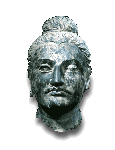Places
Kyzyl
(Qizil, Kizil) - (Lit. "red")
|
One of the Buddhist cave temple sites on the northern Silk Road not far from Kucha. Kyzyl murals contain early examples (4th - 6th c.) to mature examples (7th - 9th c.) of the Buddhist art of the Silk Road.
|
|
Miran | One of the earliest Buddhist complexes on the Silk Road, dating to the 3rd - 5th centuries. Miran was located on the eastern end of the Silk Road's southern route.
|
|
Shorchuk | A Buddhist cave temple site on the northern route (east of Kucha and Kyzyl)
|
|
Tumshuq | On the western half of the northern Silk Road not far from Kashgar.
|
|
Serindia | The appellation used by Aurel Stein for the entire eastern region of the Silk Road around the Taklamakan Desert. Its meaning combines the Latin root for silk, "seri," with India.
|
People
|
Sven Hedin - (1865 - 1952) | Swedish geographer and pioneering explorer who mapped Central and Inner Asia.
|
Sir Aurel Stein - (1862 - 1943) | The Hungarian-English archaeologist and explorer who contributed greatly to the scholarship of Central Asia and the ancient world between East and West. Stein carried out three expeditions to Eastern Central Asia (the Tarim Basin region): 1906 - 1908; 1913 - 1916; and 1930. He was the Superintendant of the Indian Archaeology Survey (1910 - 1929) in British colonial India and was knighted in 1912.
|
Paul Pelliot - (1878 - 1945) | The French linguist renowned as a Sinologist and polyglot who explored the Silk Roads of the Tarim Basin.
|
Albert von Le Coq - (1860 - 1930) | The German explorer with a capitalist background who later turned archaeologist in East Central Asia. He and Grünewedel worked for the Ethnological Museum (Museum für Volkerkunde) in Berlin.
|
Albert Grünewedel - (1856 - 1935) | The German linguist and art historian who led two of the four German expeditions into Central Asia. He and von Le Coq worked for the Ethnological Museum in Berlin.
|
Buddhism
- Vajrapani - one of the constant protectors of the historical Buddha, Sakyamuni; known in Theravada Buddhism, but became more important early in the Mahayana period. His name literally means, "Holder of the Vajra (Diamond bolt)". Seems to have derived from a combination of the Vedic god, Indra, and the yaksha figures of Indian folk beliefs.
Languages of the Tarim Region
Please keep in mind that the following languages occurred in scripts that were often derived from other language groups. The following classifications are based mainly on the orthography of the language:
|
Chinese | A language belonging to the Sino-Tibetan family that is principally used in East Asia.
|
Pali | A Middle Indo-Aryan language which was the language of the Theravadan Buddhist canon.
|
Prakrit | A Middle Indo-Aryan language used by the Gandharans. The word comes from Sanskrit and means "natural, usual, vulgar."
|
Sanskrit | An Old Indo-Aryan language considered the classical language for the Hindus but also the sacred language of the Mahayana tradition. The word means "prepared, cultivated, purified, refined."
|
Sogdian | A middle Iranian language that became the major language for trade on the Silk Roads.
|
Tibetan | A language belonging to the Sino-Tibetan family and spoken by the inhabitants of Tibet with southern dialects spoken in Nepal and Bhutan
|
Tokharian | An extinct Indo-European language once spoken in the Tarim River Basin.
|
Uighur | A southeastern, Turkic language of the Altaic family used in the Uighur Autonomous Republic (Xinjiang, China)
|


